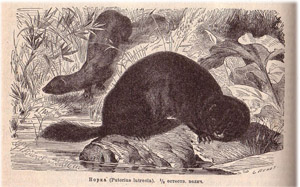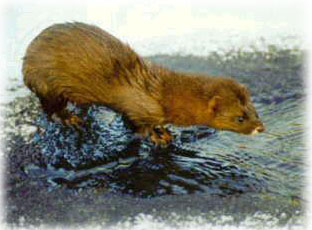[wp_ad_camp_1]
aka … minx, nurik, and vison. Also minx otter [Obs.] [1913 Webster].
Etymology
1431, “skin or fur of the mink,” from a Scand. source. (cf. Swed. menk “a stinking animal in Finland”). Applied in Eng. to the animal itself from 1624.
Appearance
The European mink is similar to a ferret in that they have long, lithe bodies, short legs and a short tail.
They have rich dark brown, almost black, fur which is luxuriously thick, and a distinctive small band of white fur around both the upper and lower lips. Their undercoat is water-repellent. There are also some European minks which have white markings on their throat, chest and stomach as well.

They are semi-aquatic and their partly webbed feet help them to swim and dive, as well as to hunt underwater. However their eyesight isn’t particularly adapted to seeing underwater so they tend to rely heavily on their sense of smell when seeking food.

Size
Males and females look very similar but, like with most mustelids, the males are much larger.
Total length (head to tail) : males – approx 60cm; females – 50cm.
Weight : males – 600g – 1kg; females – 400g – 800g.
Breeding
Mating usually takes place from February to March and the kits are born in April and May.
The litter can produce 2-7 kits but the average is usually 4-5.[wp_ad_camp_2]
The kits open their eyes around 4 weeks old; baby teeth appear within 15-17 days and then are replaced by adult teeth when they kits are 60-72 days old.
The kits are weaned by 10 weeks and start going out on their own when they reach 3-4 months old.
Lifespan
The European mink can live to at least 6 years in the wild. Captive minks have been known to live up to 12 years.
Distribution & Conservation Status

Back in the early 20th century, Mustela lutreola was a common sight throughout the European continent. Now it’s considered the most endangered carnivore in Europe.
It used to inhabit a huge area from the Ural mountains to eastern Spain, and from central Finland to the Black Sea. At present there are only isolated populations to be found in one-fifth of its former range.
Experts can’t be sure what caused the decline in population but think some of the contributing factors include the introduction of the American mink, a reduction in suitable habitat thanks to humans and over-hunting.
Habitat
Being semi-aquatic, the European mink lives in the densely vegetated banks of creeks, rivers and lakes and is rarely found more than 100m from fresh water.

Diet
The European mink is a carnivore.
It eats small mammals, like the water vole, birds, frogs, molluscs, crabs, fish and insects.
Conservation Status
The European Mink is considered Critically Endangered on the IUCN Red List of Threatened Species website (wef Dec 2015)
Some interesting videos about European Minks …
 European Mink “Life Lutreola Spain”
European Mink “Life Lutreola Spain”
 European mink pups 25 days old
European mink pups 25 days old
[wp_ad_camp_3]
How to say European Mink in different languages
-
- Aragonese: nuria europeya
Basque: bisoi europarra
- Bulgarian: Европеската норка
- Czech: norek evropský
- Danish: europæiske mink
- Dutch: europese nerts
- Estonian: euroopa naarits
- Finnish: vesikko
- French: vison européen, vison d’Europe
- German: europäische nerz
- Hungarian: európai nyérc
- Italian: visione europeo
- Korean: 歐洲水貂
- Lithuanian: europinė audinė
- Norwegian: europeisk mink
- Polish: norka europejska
- Portuguese: doninha européia
- Romanian: noriţă , nurcă , vidră mică , dihor de apă
- Russian: Норка
- Slovakian: norok európsky
- Spanish: visón europeo
- Swedish: flodiller
- Taiwanese:歐洲水貂
- Turkish: avrupa minki
- Ukrainian: Європейська норка
- Vietnamese: chồn vizon
Links to interesting sites …
 Ferret Center This site talks about the “Khonorik”, which is a hybrid of the polecat and European mink
Ferret Center This site talks about the “Khonorik”, which is a hybrid of the polecat and European mink
 WAZA – World Association of Zoos and Aquariums – Virtual Zoo
WAZA – World Association of Zoos and Aquariums – Virtual Zoo
 You can download an old (1995) pdf entitled “Why is the European Mink (Mustela lutreola) disappearing? – A review of the process and hypotheses” HERE.
You can download an old (1995) pdf entitled “Why is the European Mink (Mustela lutreola) disappearing? – A review of the process and hypotheses” HERE.
Return from European Mink (Mustela lutreola) to All About Ferrets

Deprecated: str_contains(): Passing null to parameter #1 ($haystack) of type string is deprecated in /home4/kitchast/public_html/wp-includes/comment-template.php on line 2684